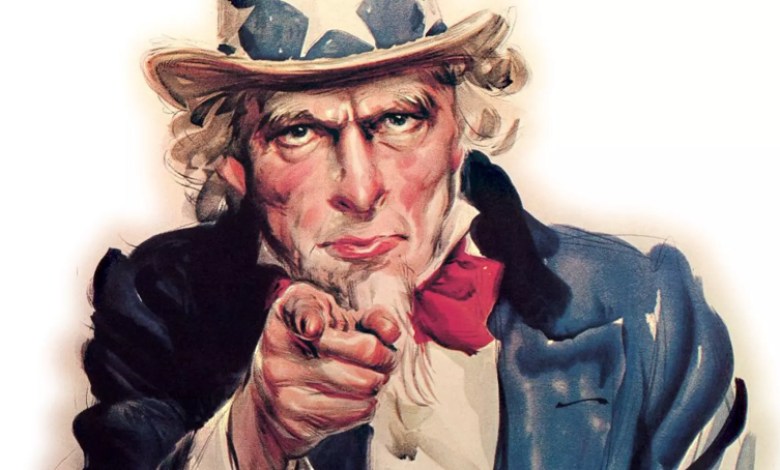
In 1961, “Uncle Sam” was officially recognized by the Senate as an embodiment of the United States. He is attributed with various qualities: aware of his duties, he is also impartial, rational, determined, and humorous. Just like Americans, some say.
Uncle Sam is one of many American national allegories. The first was Columbia, a matriarch dressed in the attire and symbols of a Greek goddess, who guided the colonists westward. After the erection of the Statue of Liberty in 1886, Columbia was replaced by Lady Liberty as the symbolic female figure.
On the male side, it was initially Yankee Doodle who symbolized the United States. Born around 1780, during the height of the War of Independence, he emerged from the nickname given by the British to the colonists of the New World, representing the audacity of youth in relation to its mother, Britannia. Soon, Brother Jonathan also appeared, a figure from the folklore of the War of Independence, who somehow always triumphs. Jonathan’s distinctive attributes include a top hat and striped trousers.
Does that ring a bell? In fact, Brother Jonathan and Uncle Sam are closely linked. Originally, they shared the role of state symbols, but in the 1860s they merged to become the current uncle of Americans. According to legend, the concept of Uncle Sam was born during the Anglo-American War of 1812-1815.
A Butcher as a Model
A certain Sam Wilson is said to have served as the model. In 1789, Wilson and one of his twelve siblings moved to Troy, a growing city in the west, to seek their fortune. They founded various businesses, from a brickyard to a distillery. By the turn of the century, the Wilson brothers ventured into the meat trade, proclaiming proudly in the Troy Gazette that they “slaughter, butcher, and package 150 cattle a day.” The success of the duo attracted many nieces and nephews, who came to Troy to work in the family business. And that’s how Sam Wilson became “Uncle Sam.” His relatives were not the only ones who knew him by this nickname.
That’s where the legend begins, as explained by historian Donald A. Hickey in an essay published in 2015 in the specialized journal The New England Quarterly. The war that broke out in 1812 brought significant wealth to the Wilson family; as contractors in partnership with a trader named Elbert Anderson, they secured a government contract to supply the American troops with meat. According to the contract, the initials “E.A.” for Elbert Anderson and “U.S.” for the United States were printed on the barrels of salted beef destined for the soldiers. One day, when an employee of the Wilsons was asked what these initials meant, he reportedly replied:
“Well, if it doesn’t stand for Elbert Anderson and Uncle Sam, then I have no idea!”
Is That Plausible?
Unfortunately, no. There are even older mentions of Uncle Sam that allude to the U.S. government well before the War of 1812, emphasizes Donald A. Hickey. However, one thing seems relatively certain: it was during this conflict that the term “Uncle Sam” became widespread, primarily used by war opponents. Critics associated the character mainly with complaints regarding the soldiers’ pay, which was deemed meager on the American side. “Uncle Sam has no money to pay his servants,” lamented the Massachusetts Spy in 1814.
The Self-Portrait of a Cartoonist
By the end of the war, even British soldiers stationed in Canada were using the term “Uncle Sam,” a nickname that was slowly starting to spread abroad. In the 1820s, the symbolic uncle finally took on a more positive connotation, and the character would steadily gain popularity, especially after the Civil War (1861-1865). Compared to Brother Jonathan, who represented the population of the United States, Uncle Sam evolved into a symbol of the U.S. government, quickly overshadowing his “brother” in the media after the North-South conflict.
In the 1870s, caricaturist Thomas Nast gave Uncle Sam the appearance we recognize today. He depicted him as a tall, thin man with a gray goatee, wearing striped trousers, a tailcoat, and a top hat. However, it wasn’t until the 20th century that America’s uncle achieved cult status, notably linked to World War I. Through what likely became his most famous depiction, Uncle Sam now recruits new soldiers: “I want you” – “Je vous veux” – he proclaims to those who gaze at the poster.
This idea of a man pointing at the viewer was borrowed by illustrator James Montgomery Flagg from a British poster. He used his own face as a model for Sam. This image continues to influence representations of America’s uncle today. Therefore, when we look at Uncle Sam, we are not just seeing Sam Wilson or the personification of the military history of the United States, but also an illustrator by the name of James Montgomery Flagg.



